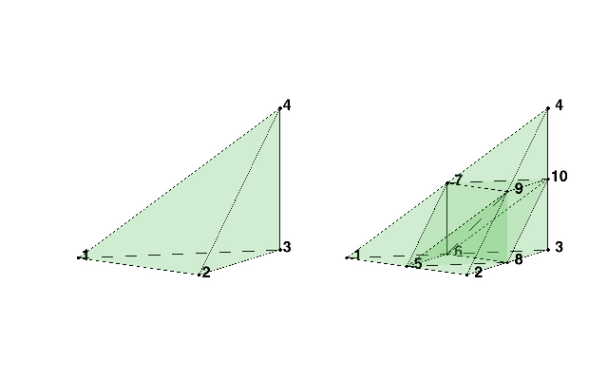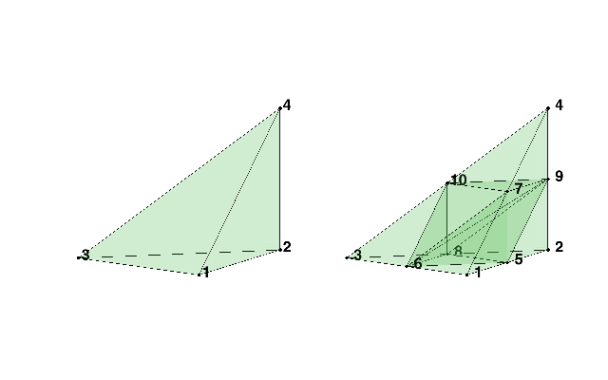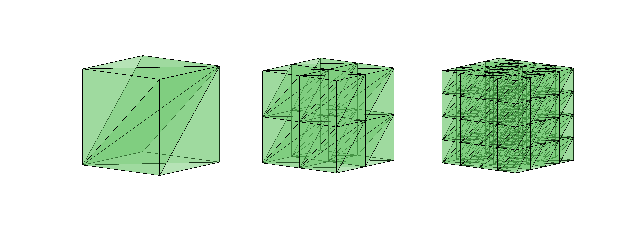3-D Red Refinement
It subdivides each tetrahedron in a triangulation into eight subtetrahedra of equal volume.
Reference:
- J. Bey. Simplicial grid refinement: on Freudenthal's algorithm and the optimal number of congruence classes. Numer. Math. 85(1):1--29, 2000. p11 Algorithm: RedRefinement3D.
- S. Zhang. Successive subdivisions of tetrahedra and multigrid methods on tetrahedral meshes. Houston J. Math. 21, 541-556, 1995.
Contents
Refinement
node = [0,0,0; 1,0,0; 1,1,0; 1,1,1]; elem = [1 2 3 4]; figure(1); subplot(1,2,1); set(gcf,'Units','normal'); set(gcf,'Position',[0.25,0.25,0.5,0.5]); showmesh3(node,elem,[],'FaceAlpha',0.15); view([34 12]); findnode3(node); [node,elem] = uniformrefine3(node,elem); figure(1); subplot(1,2,2); showmesh3(node,elem,[],'FaceAlpha',0.15); view([34 12]); findnode3(node);

After cutting the four corner, the remaining octahedron should be divided into four tetrahedron by using one of three diagonals. Here follow Bey we always use diagonal 6-9. The ordering of sub-tetrahedron is important such that recursive application to any initial tetrahedron yields elements of at most three congruence classes.
[tempvar,idx] = fixorder3(node,elem); display(idx);
idx =
6
8
Note that the orientation of the 6-th and 8-th children is changed.
Dependence of the Initial Mesh
node = [1,0,0; 1,1,0; 0,0,0; 1,1,1]; elem = [1 2 3 4]; set(gcf,'Units','normal'); set(gcf,'Position',[0.25,0.25,0.5,0.5]); figure(1); subplot(1,2,1); showmesh3(node,elem,[],'FaceAlpha',0.15); view([34 12]); findnode3(node); [node,elem] = uniformrefine3(node,elem); figure(1); subplot(1,2,2); showmesh3(node,elem,[],'FaceAlpha',0.15); view([34 12]); findnode3(node);

To have a better mesh quality, one may want to use the diagonal with the shortest diagonal (implemented in uniformrefine3l). The current algorithm didn't compute the edge length. The mesh quality will depend on the ordering of the initial mesh. For example, for the following tet, 6-9 is the longest diagonal and the refined mesh is less shape regular although still three congruence classes are possible.
Uniform mesh of the Cube
node = [-1,-1,-1; 1,-1,-1; 1,1,-1; -1,1,-1; -1,-1,1; 1,-1,1; 1,1,1; -1,1,1]; elem = [1 2 3 7; 1 4 3 7; 1 5 6 7; 1 5 8 7; 1 2 6 7; 1 4 8 7]; figure(1); subplot(1,3,1); set(gcf,'Units','normal'); set(gcf,'Position',[0.25,0.25,0.5,0.3]); showmesh3(node,elem,[],'FaceAlpha',0.25); view([38 10]); meshquality(node,elem); [node,elem] = uniformrefine3(node,elem); figure(1); subplot(1,3,2); showmesh3(node,elem,[],'FaceAlpha',0.25); view([38 10]); meshquality(node,elem); [node,elem] = uniformrefine3(node,elem); figure(1); subplot(1,3,3); showmesh3(node,elem,[],'FaceAlpha',0.25); view([38 10]); meshquality(node,elem);
- Min quality 0.7174 - Mean quality 0.7174 - Min quality 0.7174 - Mean quality 0.7174 - Min quality 0.7174 - Mean quality 0.7174

Starting from a suitable ordering an initial mesh (dividing one cube into six tetrahedron), uniformrefine3 (used in cubemesh.m) will produce a sequence of uniform mesh of a cube. In the output of mesh quality, only one exists which means all tetrahedron are of similar type.
Test mesh quality
node = [0,0,0; 1,0,0; 0,1,0; 0,0,1]; elem = [1 2 3 4]; for k = 1:5 [node,elem] = uniformrefine3(node,elem); meshquality(node,elem); end
- Min quality 0.6230 - Mean quality 0.7011 - Min quality 0.6230 - Mean quality 0.6934 - Min quality 0.6230 - Mean quality 0.6915 - Min quality 0.6230 - Mean quality 0.6910 - Min quality 0.6230 - Mean quality 0.6909
We test the quality of meshes obtained by uniformrefine3 for a different initial mesh. Now the mean of the mesh quality is changing while the minimial is bounded below.
Test boundary flag
node = [-1,-1,-1; 1,-1,-1; 1,1,-1; -1,1,-1; -1,-1,1; 1,-1,1; 1,1,1; -1,1,1]; elem = [1 2 3 7; 1 4 3 7; 1 5 6 7; 1 5 8 7; 1 2 6 7; 1 4 8 7]; bdFlag = setboundary3(node,elem,'Dirichlet'); for k = 1:3 [node,elem,bdFlag] = uniformrefine3(node,elem,bdFlag); bdFlagnew = setboundary3(node,elem,'Dirichlet'); display(any(any(bdFlag - bdFlagnew))); end
ans =
0
ans =
0
ans =
0
bdFlag obtained by uniformrefine3 is the same as bdFlagnew by finding boundary faces of the triangulation.